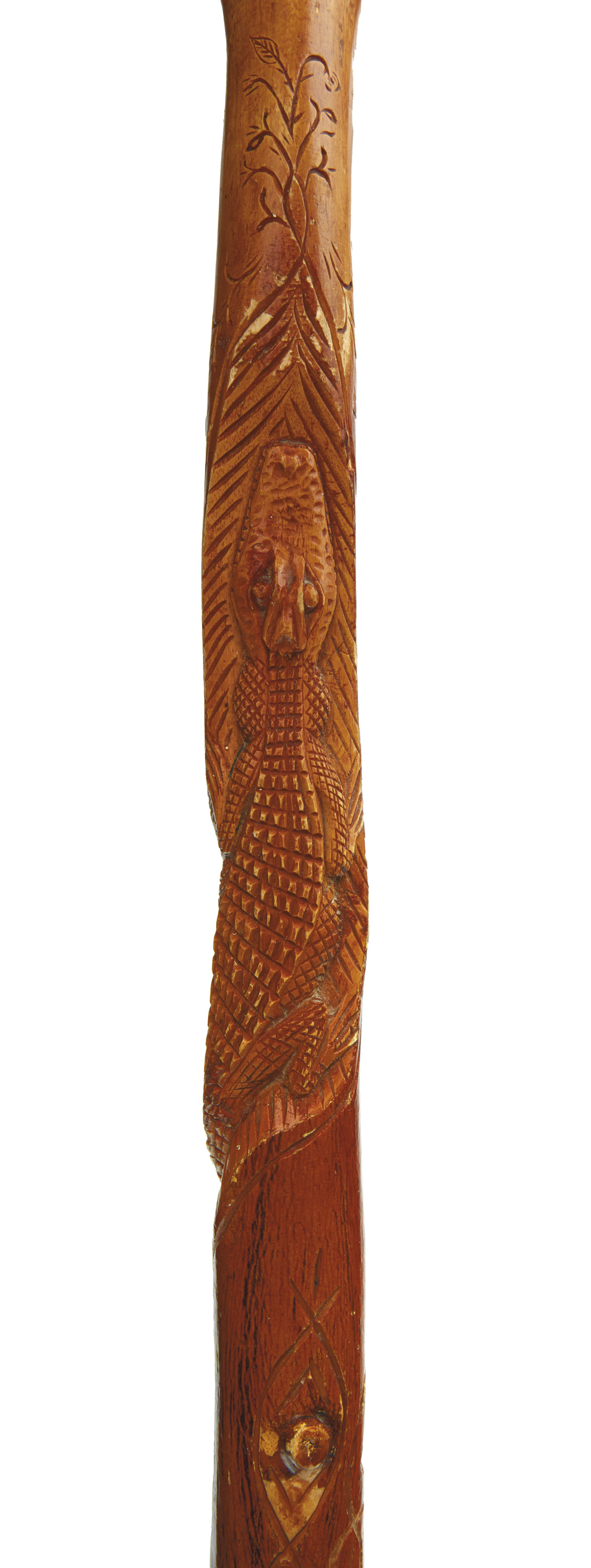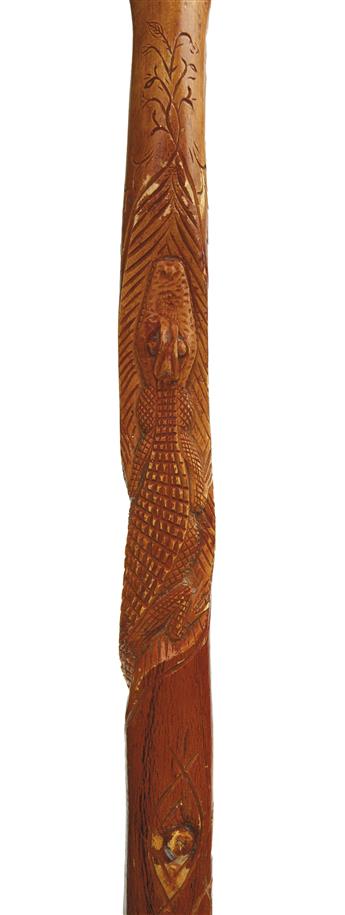Sale 2534 - Lot 65
Price Realized: $ 4,400
Price Realized: $ 5,720
?Final Price Realized includes Buyer’s Premium added to Hammer Price
Estimate: $ 4,000 - $ 6,000
(SLAVERY AND ABOLITION.) Cane said to have been a gift from Frederick Douglass to John Brown. Lacquered wooden cane, 34 1/2 inches in length and 1 1/4 inches thick at most points, carved with three alligators and other decorative motifs, with metal tip; minor wear including a few small chips. With manuscript provenance note, 5 1/4 x 5 1/4 inches; worn with several folds. Not subject to return. Np, circa 1850s?
Additional Details
John Brown and Frederick Douglass, probably the two most prominent abolitionists of their day, had a complex friendship. Douglass was impressed by Brown's vision and passion, but concerned that his plans for a violent uprising would lead to backlash against the cause. They met in person at least 9 times, in 6 different towns: first in late 1847 in Springfield, MA; again in late 1848 in Springfield; briefly in December 1856 in Rochester, NY; at a Douglass lecture in Worcester, MA in March 1857; in January-February 1858 when Brown stayed at the Douglass home in Rochester, NY for a month; at a March 1858 conference in Philadelphia; briefly in Rochester again in late March 1858; in March 1859 at the Detroit home of William Webb; and in late August 1859 in an old stone quarry in Chambersburg, PA, where Brown was making his final preparations to attack Harpers Ferry. Their meetings are discussed in Quarles, Allies for Freedom, pages 20-61.
We have found no contemporary documentation that Frederick Douglass ever gave John Brown a cane or walking stick. Nor does the cane itself bear any inscriptions. The entire burden of proof rests on a slip of notebook paper passed along with the cane for the past 140 years, on the letterhead of Pope, Berry & Hall of Burlington, VT, 10 December 1880: "Bot of Wilcox at Crown Point, NY, cane that John Brown had presented to him by Fred Douglass. Said Wilcox bought it of John Brown's widow at North Elba, NY and colored man Hasbrook of Westport. Witness, Lyon, hotel keeper of North Elba, NY. Price paid $10."
This story seems plausible. The gift from Frederick Douglass to John Brown would have likely been in the late 1850s. After Brown's execution in 1859, the cane would have been left to his widow Mary Ann Day Brown (1817-1884) at her home in North Elba, NY. Probably shortly before she sold the North Elba property in 1863, it would have been given to Josiah Hasbrouck (circa 1818-1915), an African-American farmer who was a close friend and neighbor of the Brown family. Hasbrouck resided in Westport, NY from 1871 until before 1880 when he moved to Vermont. During this period he would have sold it to a man named Wilcox from Crown Point, NY; the only Wilcox there in the 1880 census was a 27-year-old laborer named John Wilcox. On 10 December 1880, it was sold by Wilcox to George F. Pope. It has been consigned by a Pope descendant.
Any link in this chain could have been invented or exaggerated by any actor up through 1880. John Brown might have told his wife the cane was from Douglass, but it really wasn't. Mary Brown might have told her friend Hasbrouck that it was John Brown's cane, but it really wasn't. Hasbrouck might have invented a Brown family provenance to effect a sale to Wilcox. Wilcox might have invented the whole story to effect a sale to Pope, although it seems unlikely he would have gotten so many details right. Less likely, George Pope could have invented the whole story and drew up this note to support it; or the original cane could have been swapped out at some point in the intervening century to pair with the note.
On the other hand, we have found no way to disprove the story, either. We are confident that the note is dated 1880, and we have found no reason to doubt the credibility of any of the parties. If this really was a gift from Frederick Douglass to John Brown, well, that would be quite a find.
We have found no contemporary documentation that Frederick Douglass ever gave John Brown a cane or walking stick. Nor does the cane itself bear any inscriptions. The entire burden of proof rests on a slip of notebook paper passed along with the cane for the past 140 years, on the letterhead of Pope, Berry & Hall of Burlington, VT, 10 December 1880: "Bot of Wilcox at Crown Point, NY, cane that John Brown had presented to him by Fred Douglass. Said Wilcox bought it of John Brown's widow at North Elba, NY and colored man Hasbrook of Westport. Witness, Lyon, hotel keeper of North Elba, NY. Price paid $10."
This story seems plausible. The gift from Frederick Douglass to John Brown would have likely been in the late 1850s. After Brown's execution in 1859, the cane would have been left to his widow Mary Ann Day Brown (1817-1884) at her home in North Elba, NY. Probably shortly before she sold the North Elba property in 1863, it would have been given to Josiah Hasbrouck (circa 1818-1915), an African-American farmer who was a close friend and neighbor of the Brown family. Hasbrouck resided in Westport, NY from 1871 until before 1880 when he moved to Vermont. During this period he would have sold it to a man named Wilcox from Crown Point, NY; the only Wilcox there in the 1880 census was a 27-year-old laborer named John Wilcox. On 10 December 1880, it was sold by Wilcox to George F. Pope. It has been consigned by a Pope descendant.
Any link in this chain could have been invented or exaggerated by any actor up through 1880. John Brown might have told his wife the cane was from Douglass, but it really wasn't. Mary Brown might have told her friend Hasbrouck that it was John Brown's cane, but it really wasn't. Hasbrouck might have invented a Brown family provenance to effect a sale to Wilcox. Wilcox might have invented the whole story to effect a sale to Pope, although it seems unlikely he would have gotten so many details right. Less likely, George Pope could have invented the whole story and drew up this note to support it; or the original cane could have been swapped out at some point in the intervening century to pair with the note.
On the other hand, we have found no way to disprove the story, either. We are confident that the note is dated 1880, and we have found no reason to doubt the credibility of any of the parties. If this really was a gift from Frederick Douglass to John Brown, well, that would be quite a find.
Exhibition Hours
Exhibition Hours
Aliquam vulputate ornare congue. Vestibulum maximus, libero in placerat faucibus, risus nisl molestie massa, ut maximus metus lectus vel lorem.














